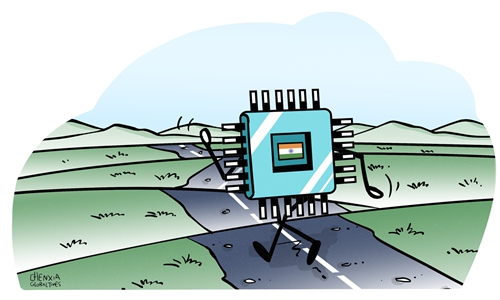
Illustratioin: Chen Xia/Global Times
With another setback for its high-end manufacturing, India's manufacturing development needs not just the government's ambition, but also the industrial planning that suits its own conditions.Apple supplier Foxconn, the world's biggest contract electronics manufacturer, announced on Monday it has pulled out of a $19.5 billion joint venture with Indian mining conglomerate Vedanta that would have produced semiconductors and display components, Reuters reported.
While concerns about incentive approval delays by the Indian government had contributed to Foxconn's decision, according to the Reuters report, the exact reasons for its withdrawal remain unclear. But still the development underscores the hardship faced by India in pushing ahead with domestic chip making plans.
After years of efforts, India's semiconductor manufacturing plans still seem to be mostly on paper rather than actual construction. While US-based Micron Technology just announced that it will build a chip packaging plant in India and will receive a subsidy worth 70 percent of the $2.75 billion cost, successive setbacks from the past plans have raised questions about the country's ability to develop high-end manufacturing industries like semiconductors, even with the high incentive.
Even though the Indian government said the Indian semiconductor market, worth $15 billion in 2020, is estimated to reach $63 billion by 2026, its ambition of relying on foreign investment to make its own chips sounds out of touch with reality to a certain extent. After all, India has no foundation in chip manufacturing in terms of technology, talent, and support of upstream and downstream industrial chains.
Maybe the Indian government believes foreign investment can help develop its own chip manufacturing, but it should be pointed out that there is no shortcut to the development of any high-end industries. Indeed, it is not surprising at all that India's chip making dream has suffered setbacks given its opaque business environment and lack of comprehensive industrial development planning.
Even if some Western companies set up chip making plants in India, they could face more obstacles such as how to find enough qualified workers. There is no denying India is a populous country, but its labor force with the basic and even high-end manufacturing capability may not be enough as they have not yet had the opportunity to grow along with industrial upgrading.
Take China as an example. China's labor force was not raised to the level in one day to be able to produce chips and electronics. In the past, low-end processing sector helped China expand its skilled labor force, which gradually evolved to meet the needs from more and more advanced industries.
This is why India needs a comprehensive industrial plan from the low-end to the high-end. Without low-end manufacturing, it cannot cultivate labor force skilled enough for high-end manufacturing. Of course, how to improve the quality of labor force is a complicated question, involving both manufacturing and basic education.
India's ambitious plan in terms of producing its own chips has much to do with the US, which has been wooing India to replace China's position in the industrial chain, especially the semiconductor industrial chain. But a growing number of cases show that geopolitics-oriented industrial development path is a dead end, which will lead to temporary hype, not practical effect on the manufacturing development. Instead of blindly following the US strategy, India might as well improve its manufacturing foundation step by step along a path that suits its own conditions. And it can start with developing low-end manufacturing, cultivating labor force, improving business environment, and strengthening cooperation with major partners including China.



